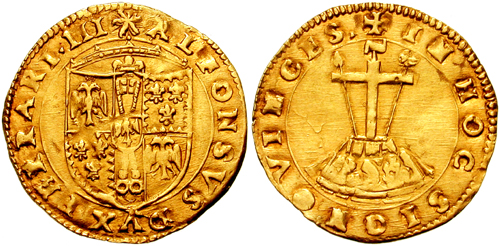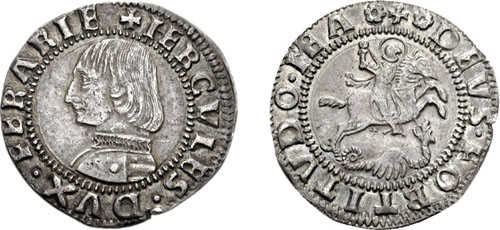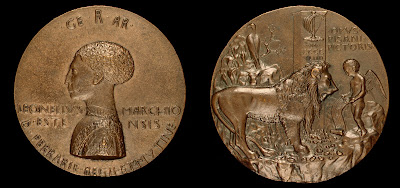
http://www.coinarchives.com/w/lotviewer ... 55b3e01b7fRenaissance Italy. Regional Schools. School of Ferrara. Alfonso I d’Este (1476-1534), later (1505) Third Duke of Ferrara, uniface Spectrum or Lead-based Medal, 1477, at the age of one, infant bust left, hair neatly defined, ALFONSOVS MARCHIO ESTENSIS, 66mm (Hill, Corpus 118; Arm II, 89, 1; Pollard [2007] 63; Kress 41). The blank reverse with finely polished surface, an old aftercast, very fine. The medal is usually found with a reverse showing Alfonso as Hercules wrestling with two snakes and was probably issued to commemorate the betrothal of Alfonso to Anna, daughter of Galeazzo Sforza. Luke Syson has attributed the medal to Cosmé Tura. Hall [in a private conversation] explains the polished reverse by stating the piece to have been made as a mirror From The Micheal Hall Collection. £200-250
************

Testone of Ercole I of Ferrara
Found: ... http://www.suite101.com/content/the-ren ... es-a231372
************

Found: http://commons.wikimedia.org/wiki/File: ... onso_I.jpgItaly, Ferrara. Alfonso I d'Este. 1505-1534.
AR Testone (9.63 g, 4h).
•ALFONSVS•DVX•FER•III•S•R•E•CONF•, cuirassed, bearded bust left
•DE•FORTI•DVLCEDO•, Samson seated left, in Roman style, holding lion mask from which a swarm of bees issues forth, serpent entwined around stump before him.
CNI X pg. 446, 34; Morosini I pg.141, 4.
**************

Found: http://commons.wikimedia.org/wiki/File: ... 27este.jpgItaly, Dukes of Ferrara. Alfonso I d'Este. 1505-1534.
AV Scudo d'Oro (3.35 g).
ALFONSVS DVX FERRARI III, arms of Ferrara
+IN HOC SIGNO VINCES, Calvary cross.
CNI X pg. 444, 11; Friedberg 269.
*************

Found ... http://commons.wikimedia.org/wiki/File: ... cole_I.jpgtaly, Ferrara. Ercole I d'Este. 1471-1505.
AR Grossone (3.55 g, 3h).
+ HE(ligate) RCVLES • DVX • FERARIE, armored bust left
+ DEVS • FORTITVDO • ME(ligate) A, Saint George on horseback, clad in Renaissance armor, riding down the Dragon.
CNI X p. 438, 39; Morosini I p. 133, 10; Biaggi 771.
***************
Picture at: http://www.mkjassociates.com/cgi-bin/il ... 1&lot=4099Ferrara. Ducat, ND. Fr-265; CNI-X,pl.XXX,8. 3.48 grams. 24.11 mm. Ercole I D'Este Duca II, 1471-1505. Obv. Portrait bust left. Leg: +.HERCULES.DVX.FERRARIAE. Reverse: Seated haloed Christ with staff in left hand. Leg: .SVREXIT.XPS.REX.GLE. Lovely renaissance portrait ducat. Rare. NGC graded AU-55. .
****************

http://artblogbybob.blogspot.com/2008_0 ... chive.htmlPisanello, Veronese, c. 1395—1455. Obverse: Leonello d'Este, 1407-1450, Marquess of Ferrara 1441; Reverse: Lion Being Taught by Cupid to Sing, 1444; bronze; diameter: 10.3 cm (4 1/16 in.). National Gallery of Art, Washington. Samuel H. Kress Collection.
***************

http://www.coinarchives.com/w/lotviewer ... ed0cf279f1Renaissance Italy. Antonio de Pucci, called Pisanello (c.1394-1455). Leonello d’Este (1407-1450), Marquis of Ferrara, Duke of Mantua and (from 1441-1450), Duke of Reggio Emilia, cast Bronze Medal, before end of 1443, bare head left with short, curled hair, three juniper branches separate the words of the legend, LEONELLVS MARCHIO ESTENSIS , rev two naked men standing, heads touching, holding up laden baskets, to either side rain from clouds falls on flaming bombs, OPUS PISANI PICTORIS , 68mm (Hill, Corpus 27; Arm I, 3, 6; Pollard, Bargello I, 8; Pollard [2007] 7; Kress 7; Syson & Gordon 3.40a, b ). An early and perhaps contemporary cast, details soft under bust, very fine. The meaning of the reverse is obscure. Hill interpreted it as an allegory of peace, assuming the baskets are full of branches of laurel, “an impressa for the Festina Lente (Wind)”. Pollard [2007] catalogues the baskets as filled with olive branches. Antonio de Pucci, called Pisanello (c.1394-1455) Antonio de Pucci, called Pisanello (c.1394-1455). Pisanello was already a famous artist, renowned for frescoes, murals, small easel paintings and portraits, when he turned his attention to metal and became the father of medallic art. Along with his painted work, extant examples of preparatory sketches for his medals survive in the Louvre and reflect his skill as a draftsman in addition to his clarity of observation. To this day he is recognized as one of the most important artists of the early Italian Renaissance. From The Micheal Hall Collection. £4000-6000
**************

http://www.coinarchives.com/w/lotviewer ... b390aa75d3Renaissance Italy. Antonio de Pucci, called Pisanello (c.1394-1455). Leonello d’Este (1407-1450), Marquis of Ferrara, Duke of Mantua and (from 1441-1450), Duke of Reggio Emilia, an electrotype copy of a Pisanello medal, bust left, rev two naked men by mast with inflated sail, OPVS PISANI PICTORIS, 67.5mm (cf Hill Corpus 25). A museum quality copy, much as made. The mast with sail is the Este impressa known as the vela. Antonio de Pucci, called Pisanello (c.1394-1455). Pisanello was already a famous artist, renowned for frescoes, murals, small easel paintings and portraits, when he turned his attention to metal and became the father of medallic art. Along with his painted work, extant examples of preparatory sketches for his medals survive in the Louvre and reflect his skill as a draftsman in addition to his clarity of observation. To this day he is recognized as one of the most important artists of the early Italian Renaissance. From The Micheal Hall Collection. £80-120
**************

http://www.coinarchives.com/w/lotviewer ... b9c5128ba1Renaissance Italy. Attributed to Amadio di Milano (active 1437-1482). Niccolò III d’Este (1383-1393-1441), Marquess of Ferrara, cast Bronze Medal, bust right wearing soft cap, NICOLAI MARCHIO ESTENSIS , rev shield of the Este arms, N – M to either side, wreath border, 60mm (Hill, Corpus 74; Arm I, 10, 31). An old aftercast of uncertain age, nearly very fine, pierced. Attributed to Amadio di Milano (active 1437-1482). Milanese goldsmith, seal-engraver and medallist, known to have worked in the court of Ferrara From The Micheal Hall Collection. £150-250
****************

http://www.coinarchives.com/w/lotviewer ... 04703b5ffeRenaissance Italy. Constanzo da Ferrara (c.1450- after 1524). Mohammad II, Sultan of the Turks (1451-1481), cast Bronze Medal, bust of the Sultan left, SVITAVS MOHAMETH OTHOMANVS TVRCORVM IMPERATOR , rev the Sultan riding left, behind, trees and building, 112mm (Hill, Corpus 80; Arm I, 79/2; Kress 102 ; Pollard 145 ). A good very fine later cast. Constanzo da Ferrara (c.1450- after 1524). Known tohave worked at Naples , de Ferrara was chosen to paint the Sultan Mohammed II portrait at Constantinople. The following medal was presumable designed at the same time. From The Micheal Hall Collection. £1500-2000
****************

http://www.coinarchives.com/w/lotviewer ... 94843fc57cRenaissance Italy. Sperandio da Mantova (c.1425-1504). Lodovico Carbone of Ferrara (c.14361482), poet, Lead Medal, bust left, CANDIDIO PVRA CARBO POETA NIVE, rev Carbone receiving a wreath from the Muse Calliope, HANC TIBI CALLIOPE SERVAT LODOVICE CORONAM, 65mm (Hill, Corpus 359; Arm I, 66/13; Kress 114; Pollard 81). A later cast, fine. Sperandio da Mantova (c.1425-1504). Sperandio was the son of a goldsmith and worked in cities throughout northern Italy , including Venice where he died. He was prolific and a master of the portrait medal. From The Micheal Hall Collection. £50-70
